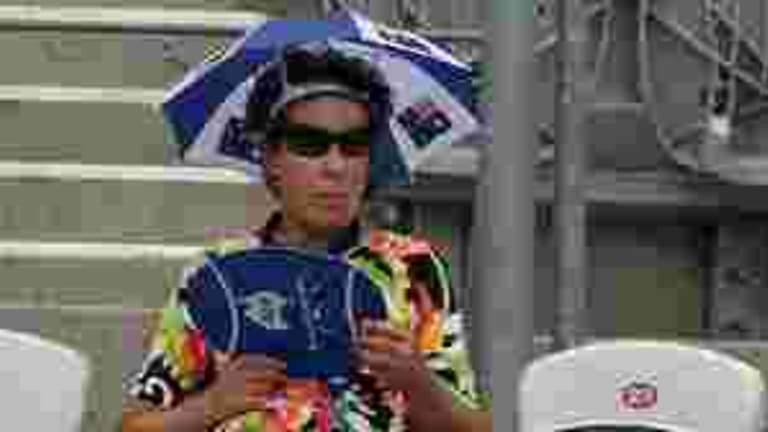“(It’s) too hot to play tennis. Even for players, for ball kids, for the people sitting out there, I think it’s just too hot. We just see each other in the locker room after the matches and I think all of us just saying that it’s too hot. Sometimes you’re playing because it’s automatic thing and sometimes not thinking because it’s just so hot that you cannot really. . . The first main thing is just to stay calm and trying to survive.”—Agnieszka Radwanska, on the heat plaguing the Sydney tournament.
Tennis Australia has always flirted with danger during the Aussie summer, when the burning wind whistles in off the Outback and temperatures often soar above triple digits (Fahrenheit). The Sydney tournament, like the Australian Open, has an “Extreme Heat Policy,” but it consists of a complex formula—including elements like the humidity, wind, and even radiation—and is called into play at the discretion of the tournament director.
In this, the tournament appears to be playing with fire—literally.
Yesterday, the temperature in Melbourne hit 106 degrees and a number of players were treated for heat stroke. The stadium, at the end of Radwanska’s win over Kimiko Date-Krumm, was virtually empty as spectators had long abandoned the cause. Yet play went on.
Leaving questions about the real-world validity of the Extreme Heat Policy out of it, let’s be realistic here. Because Sydney butts right up against the first Grand Slam of the year and already runs on a tight schedule, losing a day or two is almost certain to cripple the chances of any Aussie Open contender next week (or, in similar cases, in the future). And the ATP and WTA already have prohibitions against playing more than one match per day.
Now imagine the liability issues—and potential payout in a law suit—should a promising young player experience a debilitating injury as a result of the heat. By most all accounts, play ought to have been suspended yesterday, and in allowing it to go on the tournament was asking for trouble.
The good news: The heat is supposed to break on Wednesday.
<em>*</em>
“We haven't been able to find a tie-break that went longer than this.”—The International Tennis Federation, via Twitter, on the 70-point (yes, that, seventy) tiebreaker played in a Futures event in Florida on Sunday.
Move over, John Isner and Nicolas Mahut, and make room for Monaco's Benjamin Balleret (world No. 636) and his unranked countryman Guillaume Couillard. Balleret won the first set of his match with Couillard, 7-6 (36-34).
In some ways, that’s even more improbable than Isner’s 70-68 fifth-set win over Mahut at Wimbledon a few years ago, simply because exchanging holds on grass leaves each player with a lot more room for error.
The previous record for the longest tiebreaker in singles was 38 points, reached (oddly enough) four times—Bjorn Borg, Andy Roddick, Roger Federer, and Goran Ivanisevic were the winners in those. But this score is of a different order of magnitude. A 36-34 tiebreaker contains at least 30 set points.
After securing the tiebreaker, Balleret went on to win the second set 6-1. The bad news for the two lads is that, as there was no chair umpire and the event was a third-tier Futures, the record will not be acknowledged, at least not by the ATP. It will be curious to see how the ITF feels about it.
<em>*</em>
“He tanked at the French Open and he tanked at the U.S. Open. He’s way more talented than that. I don’t know why it happened, but it did. . .Bernard (Tomic) needs support. He needs another type of father figure. He’s now got to the stage where this is a situation where it’s finely balanced for his career and it’s clear he needs support. He’s a Top 10 player, but at this stage he’ll be very lucky to get to the Top 10 the way he’s going. He needs to decide to work harder.”—Former Wimbledon champ Pat Cash, on his offer to coach Bernard Tomic, quoted in Brisbane/Queensland’s Courier-Mail.
With the Australian Open coming up next week, Tomic probably didn’t need Pat Cash to fire so outspoken a salvo in his direction, even if it was done with the best of intentions. But then Cash, who upset Ivan Lendl in the 1987 Wimbledon final, has never been one to shy away from controversy, or reluctant to tell us how he really feels.
And when you come right down to it, Tomic could certainly benefit from borrowing some of the fire that always seemed to burn in Cash’s belly, whatever his coaching skills—or lack thereof. Cash, while barely nudging six feet, was one of the great serve-and-volleyers of the Open era. Cat-quick, he played from a semi-permanent crouch and did almost all of his damage on hard courts and grass. He won only six tour titles, but rose as high as No. 4 and played some exceptional Davis Cup matches.
Cash proudly modeled himself on John McEnroe (in some of the worst as well as best ways), and had a running feud with his native press— something for which Tomic has also shown a natural talent. He also descried the “tall poppy syndrome,” a tendency among Australians to cut down to size anyone with an extra-large personality and/or conspicuous success.
Cash had terrible back problems, but I’m not convinced anyone has ever worked harder, or given more effort on the court. That alone suggests that Tomic ought to think about his offer.
